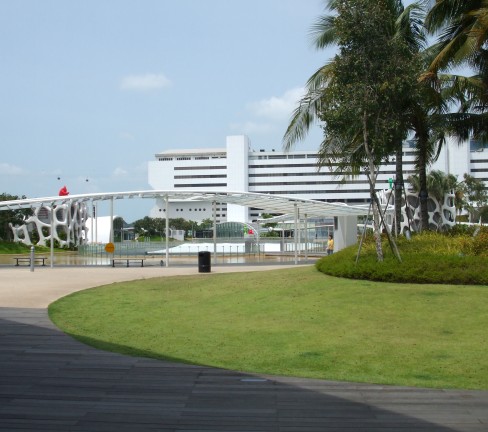
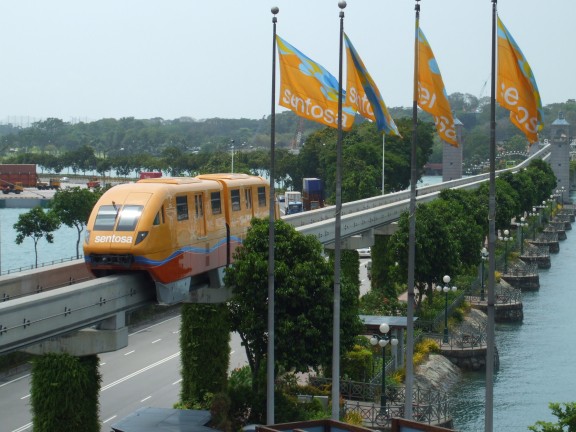
Now I have a couple of hours to think why this has gone wrong: My bicycle is an odd piece of luggage and the ladies at the check-in were pretty much lost (yes, my travel agent had notified the airline that I was going to bring a bike). The bike stayed at the check-in until the last moment, when it was picked up. It's like this most of the time, so I have to rush through the security check.
The security check is very thorough, these days. In order to keep up with new tricks of criminals, the actual list of prohibited items is longer than the one published. Items that rarely show up in passengers' luggage (such as bicycle tools and spares) are suspect. The same goes for items that are badly worn or home-made, they don't have to have sharp edges or points to be rejected. I should have given-up some of my "irreplaceable" tools and spares, I might well survive without them. And I should rightaway have checked-in doubles of these parts, with a good chance of them not being removed from my checked-in luggage and my carry-on luggage at the same time. I'll do better next time.
At this point you may wonder what parts the security check considered offending: Cable ties (a whole bag of them), brake pads (9 pairs), break and gear cables, cassette tool, spoke tool, spare spokes, combination pliers, miniature screwdriver handle and bits, pocket pump, tire repair kit, a handful of odd nuts and bolts, a ceramic water filter.
Well, FRA is not the best place to kill time, so I walk around and end up at the food court where I spend a few hours on a drink. Later that night I board SQ325 which safely carries me to Singapore.
After breakfast we go to Vivo City, Singapore's trendiest shopping mall. It's just next to the HarbourFront Centre. The rooftop is the place to go. There's some green, a large shallow pool, good views.


The monorail from Sentosa Station is the fastest way to go from Vivo City to Singapore's recreational island. I buy a return ticket and go. It's a weekday, few people visit. For me it's the first tropical sand beach after 5 years and I definitely enjoy the warm sand and water in spite of all the vessels anchored in view. Other Sentosa attractions are "Sentosa Luge" (a chair lift takes you up a hill, then you come back down on a personal wheeled sledge), a suspension bridge, twin observation towers, restaurants, "Underwater World' (a nice aquarium), a bicycle rental operation.
In the evening, two old friends take me out for a Burmese dinner. Thank you guys, this was nice.
My flight to MDC (Manado) / Indonesia is MI276 (Silkair), departing at 10:35 next morning. When I get to Changi Airport, SQ staff still has no news about my luggage. Hopefully it's in MDC, but the computer can't confirm this. I board the plane, enjoy a smooth flight and this feeling of excitement that I get everytime I enter Indonesia.

The visa-on-arrival process in Manado is a bit confusing and involves paying USD25 but officials are nice and helpful, plus there's a money changer. After not even 30 minutes, I have my 30 day visa. Hey, I made it ! I'm in Indonesia !
A few steps past the immigration there's the baggage pickup area. And there, at the back, what do I see ? My checked-in luggage, my bicycle ! Now nothing can go wrong !
The bike has suffered some scratches and bruises from the air transport, but everything is there. The handlebar bag has arrived as well and a thoughtful person has locked it into the holder on the bike. I let the Silkair staff know that everything is fine with my luggage.
Upon closer inspection of my bike, I notice that the cable ties that once held my homebrew tail light as well as the ones that held the sensor of the cycle computer have been removed and well, there isn't a sensor any more on the cable. I also find one water bottle cage and a mudguard broken. And something must have hit the headlamp and bent the bracket. The bell is somewhat deformed, too. Such things happen, particularly at FRA airport. The cable ties I blame on the security check of the Bundesgrenzschutz. They have put their "checked"-sticker on the frame.
Bottom line, no serious damage and my checked-in cable ties come very handy. I pack my stuff onto the bike, airport staff smiling at me, I'm the last passenger of this flight to leave the baggage claim area.
Outside, on ground level, there are several restaurants and ATMs of various banks. And there are counters of several airlines. I start wondering if it might be possible that I go to Kendari (KDI) this same day ? The question is quickly answered by a helpful travel agent who asks me "where are you going ?". Yes, I can go to KDI and there are various airlines I can choose from. I would have to go via Makassar (UJP) though, so I need two flights. The cost is pretty much what I expected and so I appreciate Markus' fast service and buy a ticket from MDC to UJP from him. Following his advice, I don't get the ticket from UJP to KDI rightaway, as this would be cheaper to buy in UJP and better in case that my first flight arrives late. I pay the ticket in a mixture of currencies, as the ATMs at MDC don't seem to like me on that day. Soon, I board another plane, leaving Manado. This time absolutely no hassle with the security check.
As I hit this remote part of Indonesia for the first time, this is my impression:
There's lots of people living there, one town merges into another, creating a huge urban center. Not exactly jungle.
Though the area is highly populated, there's not much western influence and the standard is generally low. This feels like Makassar 15 years ago and there's just 2 small malls today (GPS RABAM, MALMAN). What they sell is rather basic. Most shoppers don't own a car, so these malls have small car parks. You get the picture.
Comparing to Manado, I feel the Kendari people are somewhat rude.
|
|
Most hotels offer free tea. Some include a small breakfast.

Kendari's two key transportation waypoints are the airport (GPS KENDAA, 30 km out of town) and the jetboat jetty (GPS KDI, in the busy harbour area).
There are several jetboat companies serving the Kendari - Raha - Bau Bau route. MV Super Jet is one of them. The trip from Kendari to Bau Bau on the MV Super Jet 15 is Rp 96000 for me and my bike (plus Rp 5000 insurance plus Rp 4000 harbor tax). It takes from 7:30 am to 12:00 with a stop in Raha. During that stop, it makes a lot of sense not to leave luggage unattended.
MV Super Jet runs 3 boats, all made from glass fiber and powered by 2 engines. They are said to be the fastest (I measure 40 km/h peak), but later I find that the larger boats of the MV Sagori Ekspres are both more comfortable and faster.
Photo: Atop the MV Super Jet 15 to Bau Bau
|
|
My first night in Bau Bau I stay at the "Villa", where I enjoy a quiet, cool and rainy evening. I do some maintenance on the bike (rear brake cable outer casing broken) and chat with the resort's staff.

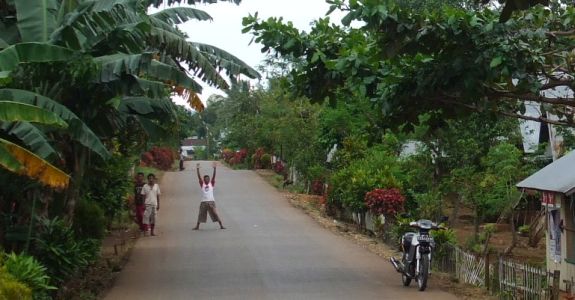 I spend the night at the "Villa" and the morning downtown Bau Bau where I find food, an ATM that accepts EC/Maestro-card, but no bicycle computer to replace mine with the lost sensor.
I spend the night at the "Villa" and the morning downtown Bau Bau where I find food, an ATM that accepts EC/Maestro-card, but no bicycle computer to replace mine with the lost sensor.Eventually I get going south. My first stop is Pantai Nirwana (GPS NIRWAN). This beach is not that big but popular with Bau Bau locals. It's Monday, so I'm pretty much alone. Some kiosk there are selling drinks and snacks, this is where I buy my water & bisquit lunch. Dilapidated huts along the beach provide shelter from the sun. Some rubbish litters the white sand beach, but it's not that there is no cleaning up at all.
From Pantai Nirwana, the road passes the villages of Lanela (GPS LANELA, the Nelles map and the local Harsena map wrongly call it Lawele), Batauga (GPS BATAUG), Laompo (GPS LAOMPO), Majapa (GPS MAJAPA), Dusumb (GPS DUSUMB, a nice view over the sea right from the road) until it eventually reaches Sampolawa.
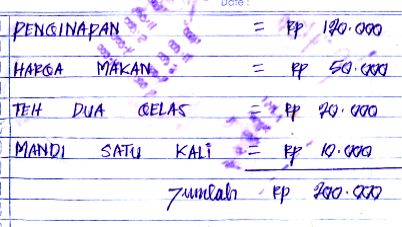 It's just about getting dark as I reach Sampolawa (GPS SAMPOL), 47 km from Bau Bau (according to the roadsigns). It's a small place and virtually everything of interest is around the harbour / market area. Lots of coal is being shipped from this harbour. There's a single restaurant & guesthouse, called Pasumbala Faya. It's very basic, the sort of place where it's best to time a shower with the rain, so that there's water in the mandi. Surprisingly, electricity is up 24h. Either this place IS expensive because of the lack of competition, or they overcharged me quite a bit at Rp 200,000 for a meal (rice, fish, vegetables), 2 mugs of tea, a shower and a tiny room for the night. This breaks all records in non-value.
It's just about getting dark as I reach Sampolawa (GPS SAMPOL), 47 km from Bau Bau (according to the roadsigns). It's a small place and virtually everything of interest is around the harbour / market area. Lots of coal is being shipped from this harbour. There's a single restaurant & guesthouse, called Pasumbala Faya. It's very basic, the sort of place where it's best to time a shower with the rain, so that there's water in the mandi. Surprisingly, electricity is up 24h. Either this place IS expensive because of the lack of competition, or they overcharged me quite a bit at Rp 200,000 for a meal (rice, fish, vegetables), 2 mugs of tea, a shower and a tiny room for the night. This breaks all records in non-value.
Westerners rarely seem to visit Sampolawa, I am THE attraction. First lots of children stare at me and men talk about economy, trade, energy. It seems they don't believe that I'm merely a tourist looking for tourist attractions. This evening, I am told that Butong is rich with oil, asphalt, gold and uranium. People hope to be better off, once this is being exploited.
In the field of tourism, I'm suggested to visit the Kraton near Desa Rongi, 14 km north of Sampolawa.
With no cell phone network in Sampolawa (they tell me it is soon coming), people tend to gather at the Wartel telephone shop at night. I spend about an hour there, first waiting in line and then trying to call home which doesn't work that day.
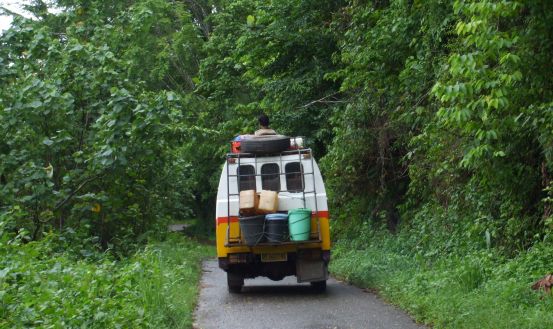 I leave Sampolawa early in the morning (Tu, 26-Feb), in order to reach Pasarwajo before nightfall. The road is climbing into the hills, rather scenic. I reach the Rongi junction where it's right for the village and left for the Kraton.
I leave Sampolawa early in the morning (Tu, 26-Feb), in order to reach Pasarwajo before nightfall. The road is climbing into the hills, rather scenic. I reach the Rongi junction where it's right for the village and left for the Kraton.I go up to the Rongi Kraton, it's a steep road. Atop the hill, friendly villagers welcome me and show me around their tourist attraction. The Kraton is nothing more than a few remaining stones of old walls, scattered between village houses. I even don't take photos. Soon a heavy rain starts, and I'm being invited into the Rumah Adat (a house with open walls where villagers celebrate and meet). I learn of a hot spring not far from my planned route, why not slot that in ?
After an hour the rain stops and I say goodbye (the road down is real slippery now), heading on to Kaongke-Ongkea (GPS KAONGK, 8 km from Rongi). At this junction village I have to turn left for the hot spring, right for Pasarwajo. I take the hot spring. Past the check point and 2 km downhill, there's a sign that marks the turnoff (right) to the "Air Panas Dokter Statler" (GPS AIRPA2), then 200 m of steep dirt road to a stream where I park my vehicle. Across the stream (by foot), another 20 m to a little pond where warm, sulfurous water surfaces (it's said to be warmer in the morning hours). Very easy to find (when a helpful motorcyclist guides you). I take a dip in the sulfurous water, on the way back another thorough dip in the (cold) stream to get rid of the sulfur. OK, hot spring done !
On the way up to Kaongke-Ongkea, it's time for some fast food at a makeshift-warung selling grilled corn cobs (jagung goreng). It's the season. Enough energy to get me up the hill and 18 km further to Pasarwajo. This stretch is climbing up to 500m high and there's lots of broken asphalt, so shortly before I reach Pasarwajo, I deserve another grilled corn cob.


Later that day I get a haircut done and ride around a little as far as Dongkala. The night I stay at Lozmen Rizki and next morning I head south to ..
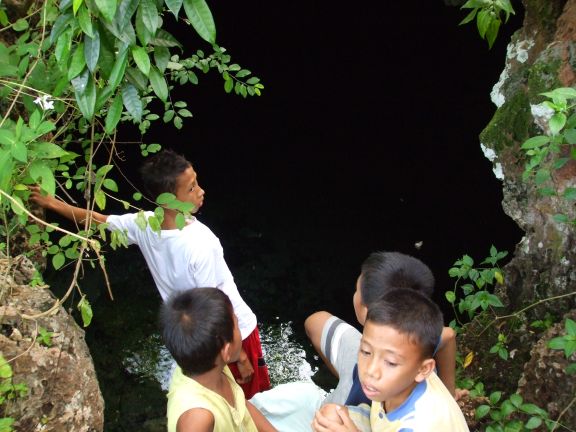 Wasuemba (GPS WASUEM) is a daytrip from Dongkala (on a mountainbike at least). It's the end of the road, unlike the Harsena local map suggests.
Wasuemba (GPS WASUEM) is a daytrip from Dongkala (on a mountainbike at least). It's the end of the road, unlike the Harsena local map suggests.
The road takes me through the fishing villages of Dongkala (GPS DONGKA), Tolando (GPS TOLAND), Wabula (GPS WABULA). They are all beautiful villages with many traditional wooden houses. When stopping for a few minutes, kids start gathering around me.
Between villages the road is climbing into the hills, and it is getting steeper and steeper the further I go south. My bike is a 27-speed and I use the lowest and highest gear most of the time. Some of the descents are frightening (so steep that it's better not to touch the rear brake, maybe 20% gradient). The road is sealed and the asphalt is mostly good.
Eventually I reach Wasuemba (GPS WASUEM). I go through it and continue on a trail beyond the village, where soon a couple of kids on bikes catch up with me and tell me that this trail ends at a beach. So we all go to the beach (GPS PANTA2), I take some photos and ask if there's any tourist attractions in the area. Well, there are lots of springs in Wasuemba and I'm happy the kids want to show me around the place.
They take me to various springs, pools, caves and tell me how these sources are used (GPS AIRMA1 = air mandi = bathing water, GPS AIRMI1 & 2 = air minum = drinking water, GUAAIR - gua air = cave with a spring and lake inside). We also visit an elevated spot (GPS VIEW1) with a nice view of the sea. The difficulty of the tour is to avoid alarming other groups of kids that then join, which is not what we want. Well, the group steadily grows and at the end sure all of them like some Rp and many get disappointed.
The only source of food in the villages are the kiosks (bisquits, cake, soft bread, instant noodles, water). On my way out, I buy a few of these things so I can cope with the hills on the way back. I put the steepest hills behind me before it gets totally dark and I arrive at Pasarwajo after nightfall. This night (27-Feb) I spend at Losmen Lambusango near the market.
In the morning, I enjoy breakfast at Rumah Makan Wangi Wangi at the northern end of Pasarwajo. I'm on my way out, I want to go north along Buton's east coast, let's see how far I get. Just as I leave Pasarwajo, I see what seems to be the local gas station on the right side of the road:

 From Pasarwajo, I follow the coastal road to the north-east. The road starts out nice, then deteriorates as I move on. More and more broken asphalt, partially overgrown, increasingly steeper hills, bridges with holes. I wished my bike had stronger brakes and I'm glad there's no rain. I pass the villages of Matanauwe (GPS MATANA), Kumbawaha (GPS KUMBAW), Ambuau (GPS AMBUAU), Lasalimu Pantai(GPS LASALI), Wasuamba (GPS WASUAM). At some of the junctions along the way, it is not obvious where I have to turn so I ask passing motorcyclists or farmers.
From Pasarwajo, I follow the coastal road to the north-east. The road starts out nice, then deteriorates as I move on. More and more broken asphalt, partially overgrown, increasingly steeper hills, bridges with holes. I wished my bike had stronger brakes and I'm glad there's no rain. I pass the villages of Matanauwe (GPS MATANA), Kumbawaha (GPS KUMBAW), Ambuau (GPS AMBUAU), Lasalimu Pantai(GPS LASALI), Wasuamba (GPS WASUAM). At some of the junctions along the way, it is not obvious where I have to turn so I ask passing motorcyclists or farmers.Wasuamba is abt one kilometer seawards from the mainroad junction. I ride into the village and find 2 kiosk where I enjoy water and bisquits before I visit the jetty and the part of the village that is built on the water. I notice that roads, jetty and walkways are in urgent need of repair.
I continue the last few kilometeres to Kamaru. On the left side of the road I notice a little spring with a tiny artifical basin below. A coconut bowl is provided so I can wash my bike and refresh myself. As I get close to Kamaru, the road is becoming wide and smooth again.
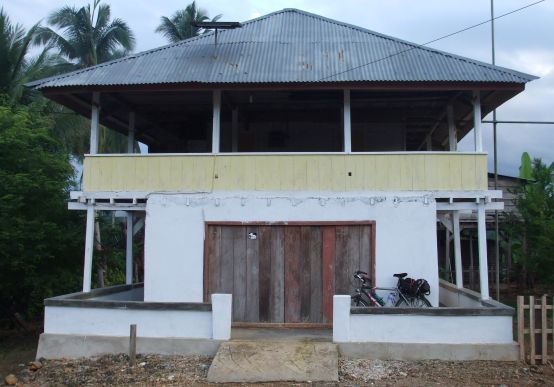 Kamaru's first penginapan (guesthouse) has just openend, it is so new that it doesn't have a name yet. At Rp 15,000 per room it's incredibly basic (bring your own light, blanket, mosquito coils, ..). |
 Alternatively, it's possible to stay at Kiosk Ani. She has a room that she rents out at Rp 25,000 with breakfast. It looks like this could be better than the guesthouse. For Kamaru's best (and only) dining, there's no way around Ani's combined restaurant and photo studio ("Kiosk Ani"). The menu is short but the food is hot. |
|
|
|
|
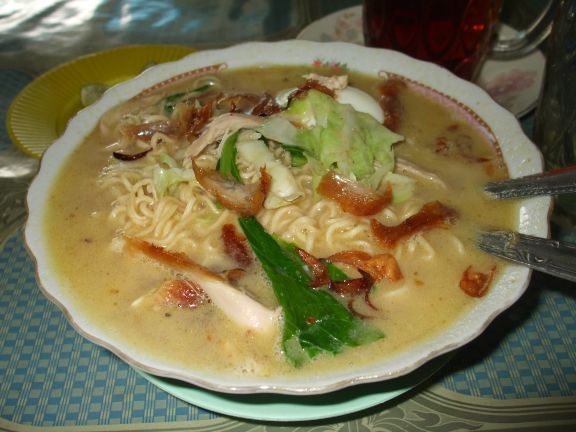 I have to think about Raha. Somehow this place is different, the people too. I've noticed it on the road to Raha already, people are noisy and more often than elsewhere I hear the obligatory "hello mister" - "thank you" - "fuck you" - "how are you" - "what is your name". The drivers on the road are on the aggressive side, particularly those driving shiny new vehicles. Judging from the sports facilities available (stadiums and huge pools for rowing competition), the Rahans must exercise a lot. And they need space, a lot of it. The extremely spacious layout of Raha makes it necessary to have a vehicle for virtually any errand.
I have to think about Raha. Somehow this place is different, the people too. I've noticed it on the road to Raha already, people are noisy and more often than elsewhere I hear the obligatory "hello mister" - "thank you" - "fuck you" - "how are you" - "what is your name". The drivers on the road are on the aggressive side, particularly those driving shiny new vehicles. Judging from the sports facilities available (stadiums and huge pools for rowing competition), the Rahans must exercise a lot. And they need space, a lot of it. The extremely spacious layout of Raha makes it necessary to have a vehicle for virtually any errand.

At Napabale, I hear about a place called "Pantai Meleura". Not exactly a beach as we know it, because there is no beach. Still there is sand under the surface of the water and the bay makes for good swimming. The place is 8 km away, too close to miss it. Though not far, the hills on the last kilometer are steep and tough. When I arrive, it has gotten late so I rush to take photos while good daylight lasts. Near the water there's a large rock with stairs up to a viewpoint, just perfect for my photo session. Half the village's kids follow me up and down again.
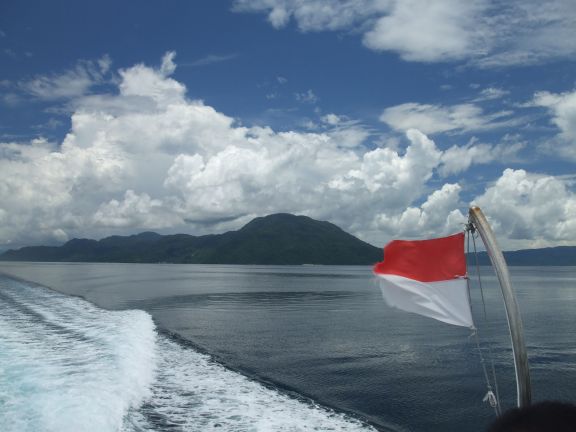 On my way out from Pantai Meleura, I do a little detour to a freshwater lake (GPS MANDI7, when coming from Meleura turn left at the junction after the steep hills). It's a scenic lake in the forest, well-visited by locals who do their washing and bathing. The rubbish top runners are washing powder and shampoo sachets, floating in the water. I enjoy my last swim of the day before I hit the road and pedal back to Raha.
On my way out from Pantai Meleura, I do a little detour to a freshwater lake (GPS MANDI7, when coming from Meleura turn left at the junction after the steep hills). It's a scenic lake in the forest, well-visited by locals who do their washing and bathing. The rubbish top runners are washing powder and shampoo sachets, floating in the water. I enjoy my last swim of the day before I hit the road and pedal back to Raha.
As I'm coming into Raha from the south, I pass near "Tempat Mandi Jompi" (GPS JOMPI). It's at the end of a residential area and not far from Hotel Rambutan. The hydroelectric power plant has a little recreational area nearby and some place to swim or wash a motorbike. I reach there after nightfall, record a GPS waypoint, have a short rest and move on to Raha center. It was a 73 km day.
Dinner is warung food and Saraba, a hot drink made from tea, ginger, sugar and milk. At the warung I meet a group of Rahans who recommend I visit a place called "Pantai Bajala" in the west of Muna. This sand beach boasts three different colors of sand: Red, white and brown. Pantai Bajala is a 1.5h car trip from Raha. This time I'm not going to visit it, though.
Both the MV Super Jet and the MV Sagori Ekspress depart from Raha at 9:00 am. The Super Jet is sceduled to arrive at Kendari at 15:00, the Sagori Ekspress at 12:30 hours. Traveling on the Sagori Ekspres at 43 km/h + consistently, I see the Super Jet disappear on the horizon.

Meanwhile I know it's not necessary to go to the university first, the direct way to Air Jatuh Kambu is this (16 km from the Cendrawasih Hotel):
Go around the bay anti-clockwise, past Kubra Hotel, left at the next roundabout, follow the road until "simpang tiga" where you turn right onto Jln Malakka. From "simpang tiga", follow Jln Malakka for 8 km straight (road becomes neglected after the police HQ, little traffic then). As you go, look out for a bridge with a mosque right after (left side of the road). Between the bridge and the mosque, turn left onto an unpaved, small road. This point is marked GPS 2WAFA8. Follow the road up to a dam (GPS DAM1) and from there to a man-made reservoir. There are stairs, go up (by now there are two local kids with me, showing me the way). Follow the trail / the water pipe until the path descents to the stream (left side). Walk upstream in the water until you reach the waterfall (GPS WAFA8). From the stairs, this is a 15 min walk.
Though it's the end of the rainy season, there is little water when I visit. My guides say it's a lot more when there's rain. Rain or no rain, Kambu waterfall is nothing spectacular: One tier, a small pool at the bottom, nice forest around it. Still a good destination for a half-day trip. As we return from the waterfall to the mainroad, I notice the kids' bicycles have working brakes and gears and when I mention it, they feel proud. Having arrived at the mainroad, we talk about playgrounds until dusk settles in.
The ride back to Kendari is smooth. Once back, I enjoy dinner in the area with all the seafood warung. At the hotel, I have the receptionist call me an airport taxi (Rp 90,000) for the next morning. Sleep, pack my stuff, check out, taxi is there, bike goes on the taxi, and I'm on my way to the Kendari airport. I keep an eye open for hotels on the road, not willing to believe there's nothing in the vicinity of the airport. I notice a hotel about 15 km from the airport and a resort about 10 km away. Next time I'm around, I will explore some more.
My taxi arrives at the airport well in time, virtually no traffic. Lion Air takes my bike without complaint and the flight to Manado feels exceptionally comfortable after all the land and sea transport of the past weeks. The air ticket is Rp 1,010,000 (KDI-UPG-MDC). The second leg of the journey is double safe with the safety card being supplemented by a prayer card (entering a Christian area).
|
|
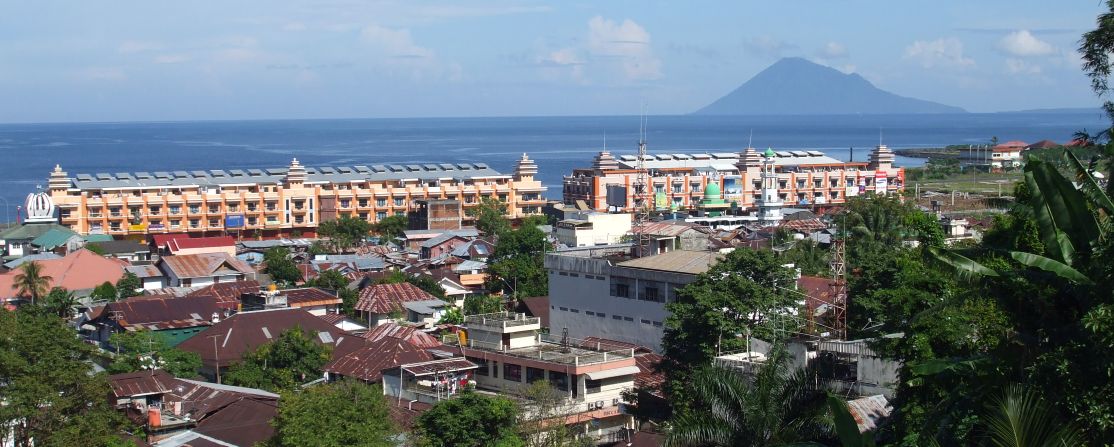
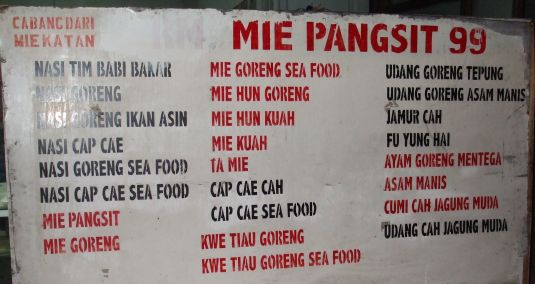
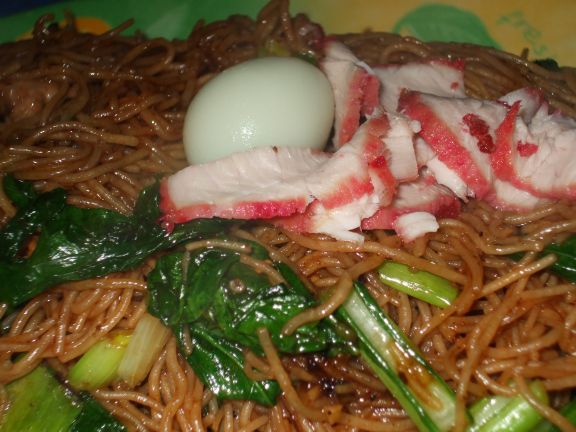 Next day is shopping. In the morning, I ride south to Pasar Karambasan (GPS KARAMB) to find some spices. It's a big market and if it comes to food, the oddest things are for sale there. This makes it a great place for taking offending photos (not showing them here). Karambasan also has a large bus station.
Next day is shopping. In the morning, I ride south to Pasar Karambasan (GPS KARAMB) to find some spices. It's a big market and if it comes to food, the oddest things are for sale there. This makes it a great place for taking offending photos (not showing them here). Karambasan also has a large bus station.My next target are the malls. Most of them are built along the sea and the gap between them is filled with smaller businesses. They are the typical Indonesian malls that host department stores, popular fast food chains, boutiques, consumer electronics & IT vendors, arcades and super markets. Several of the shops that exists in the business area between the malls do have branches inside one or more malls. These branches have not as much of a selection, so when I look for my size in slippers, I have to look outside the malls.
In the afternoon I visit Pantai Molas (GPS PMOLAS), the beach closest to Manado. It's roughly 10 km north of the city and the turnoff to the beach (GPS 2MOLAS) is hard to find. Pantai Molas is a small black sand beach that doesn't look too attractive and has no tourist facilities. Fishing villages are nearby. The water is shallow and I walk in far to be able to swim. The beach is surprisingly clean for being so close to Manado. Pantai Molas for sure can't compete with the beaches on the islands north of Manado.
Just south of Pantai Molas there are two dive operations, Nusantara Diving Center and the smaller Barracuda Diving Resort.
Another note on diving: During my stay in Manado, I hear of a dutch guy by the name of Max Ammer, the founder of Papua Diving. He operates in the Raja Ampat area (Pulau Gam, Waigeo, Batanta) where the world's best diving is said to be found. Max is a tough guy with excellent local relations, clearing any problem that competitors fail to overcome. His operation has been around for years and is going strong.
My flight out of Indonesia is next day. Again dense traffic on the road to the Manado airport. I make it just before a downpour starts. At the check-in, no problem with the bike an the excess baggage that I bring. Soon I'm sitting in the departure lounge waiting for the immigration counter to open. Meanwhile I have a go at the bag of rambutan that I have bought on the way to the airport. As I eat the fruits, ants start to appear and they seem to become more and more as I eat more fruits. Strange - when I bought them I had made sure there are no ants. I take the fruits into the washroom and carefully wash them. Back at the waiting hall, in spite of the wash, my snack turns into a little disaster with ants on the floor, over my hands and arms. Luckily, there's no people sitting around me and no cameras either. I speed up and try to contain the ants in the plastic bag with the fruits. When I'm through, I tie the bag close and dispose of it in the nearest bin, then hurry to the washroom. I return and take a seat at the other end of the hall, pretending to be busy with my cell phone. I think it all went unnoticed. Eventually the immigration officer opens the counter, clears the few passengers and I can proceed to my gate with a feeling of releave, leaving the ants behind. I imagine what would have happened if these ants had come aboard and made it into Singapore !
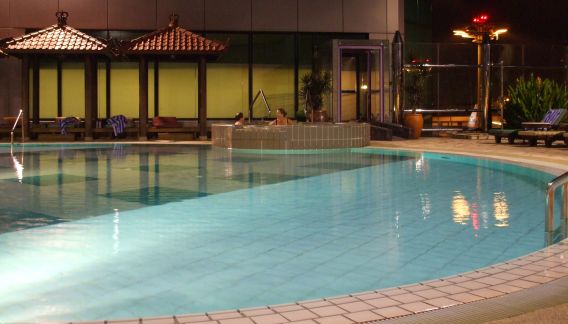
In order to kill the time until my flight to Frankfurt leaves, I seek out the open air swimming pool of the Ambassador Transit Hotel (Terminal 1). As a non-guest I'm allowed to use the facility for a fee of SGD 14, payable by cash or credit card. The fee covers a towel and a drink at the pool bar. I spend some relaxing hours, so much better than hanging around the terminals and shops.
Finally I leave on SQ26 and several hours later arrive in Frankfurt without any incident. Only as I pick up my bike, I notice that it has suffered again from the transport. Looks like they put bikes on conveyor belts instead of pushing them by hand. Well, it doesn't matter. I'm back to Germany where bicycle parts are widely available.
Reasons against using a bicycle box:
BACK to Indonesia main page